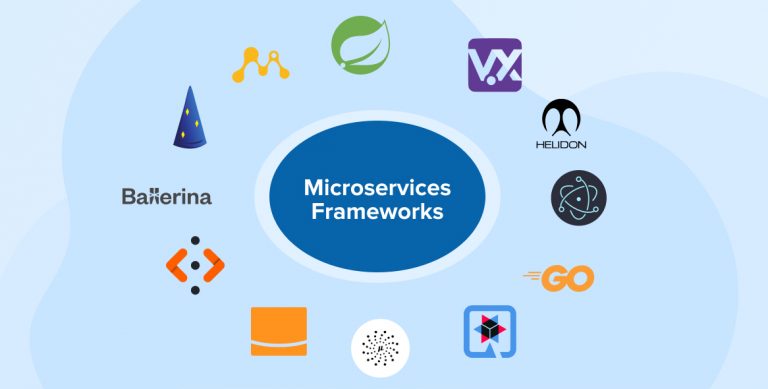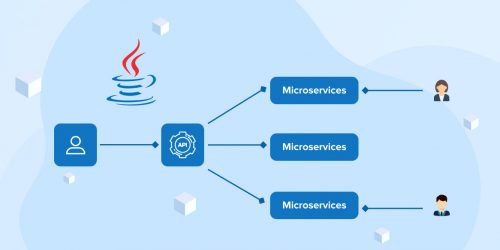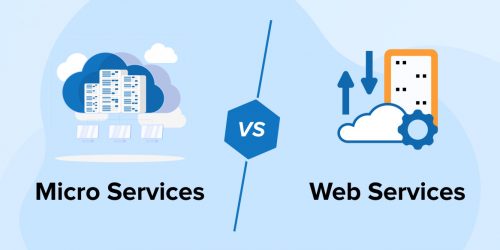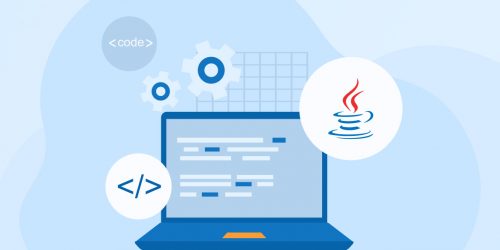Related Blogs

As a part of your business development plan, while determining the type of application you wish to create, it is advisable to select your tech stack at first to work upon its architecture before anything else. You may be winding up your day hearing success tales of the world’s biggest or Fortune 500 organizations, and you discover how they transformed their systems by employing microservices frameworks. Your eyes roll over success stories every day and that exactly is the moment you should start trusting the total potential of microservices.
To take on the task, a software development company must select a framework with all the interactive tools required to create a powerful and extremely performant application. Furthermore, these frameworks influence the capital costs, development period, handling simplicity, and long-term maintenance.
Microservices architecture is a method where monolithic single applications are fragmented into smaller apps. Different programming languages and frameworks are available to develop microservices. Their main goal is to create independent deployment models.
In this article, you’ll learn more about common microservices frameworks that you can completely trust this 2022!
1. Top 12 Microservices Frameworks
Here is the list of 12 frameworks describing their own process, and business capabilities covering the benefits of microservices frameworks in order to make you more decisive when it’s time for you to choose a proper framework for your project.
Let’s start!
1. Spring Boot / Spring Boot with Spring Cloud
Spring Boot is a prominent Java framework for Microservices application development. It offers many add-on modules on Spring Cloud for developing microservices architecture. Spring Boot enables the construction of large distributed systems beginning with a basic design composed of several cooperating components. It may be used to construct both tiny and large-scale systems. Due to Reversal of Control, Spring boot is relatively easy to combine with other popular frameworks.
Key Benefits:
- Spring MVC enables the construction of dynamic microservices apps with REST API.
- Inversion of Control makes it simple to interface with top frameworks.
- Micrometer, an additional framework for tracking useful data, distributed monitoring, and analytics.
- Cloud Foundry is utilized for horizontal scalability and integrating numerous backend services with simplicity.
- Time-to-market improvement for complicated application architecture.
2. Eclipse Vert.X
Eclipse Vert.X can be your top pick if you are searching for microservices solutions that are event-driven with regard to software development. It provides several language support, including Java, Ruby, Kotlin, Ceylon, JavaScript, Groovy, and Scala. Furthermore, the framework operates on a Java Virtual Machine, making it a perfect solution for service-oriented programs with complicated microservices architecture.
Unlike typical stacks and frameworks, Eclipse Foundation’s Vert.X features resource-efficient qualities that allow it to process several requests concurrently. It can conduct tasks in restricted environments, particularly containers. Vert.X is largely prominent as a microservice framework because of its functionalities and embedded qualities, which make it more of a flexible tool than a framework.
Key Benefits:
- It is compact in size, with a 650kb base.
- It is a flexible framework that enables developers to add as many components as necessary without introducing anything unnecessary.
- Medical tests are readily executable via Vert.X web or an event bus.
- Asynchronous unit tests are executed via Vert.XUnit
- It supports gPRC in accordance with Google’s program code.
3. Oracle Helidon
Oracle created the microservices framework Helidon. It is a set of Java libraries for writing microservices. Helidon MP and Helidon SE are the two available variants. When compared to Helidon, Spring Boot is superior in a number of ways. Helidon is fairly new and there is currently a dearth of documentation, making it difficult to locate solutions on Stack Overflow.
Helidon MP is a MicroProfile standard implementation. This makes it an excellent option for Java EE programmers. Helidon SE is a small toolkit that supports the most recent Java SE features, including reactive streams, asynchronous and functional programming, and APIs with a fluid design. Helidon SE offers GraalVM native files for low storage use and flash -like launch. Helidon SE’s REST framework is based on Netty and provides a simplistic API for session handling.
Key Benefits:
- The minimum starting time ranges between 0.09 and 2.03 secs.
- Consists of a comprehensive cloud environment with all the required and universally supported technologies.
- Comprises 2 variations, Helidon SE and Helidon MP, for specific programming needs.
4. GoMicro
Go Micro is a modular RPC-based framework that offers the core architectural blocks for constructing microservices in the Go programming language. It provides service discovery with the consul, networking with HTTP, and encryption by proto-RPC or JSON-RPC, as well as Pub/Sub.
Go Micro meets the essential criteria for constructing scalable systems. It translates the microservice architectural pattern into a set of tools that serve as the system’s building pieces. Micro addresses the complexities of parallel computing and provides programmers with simple representations they already understand.
Technology evolves continuously. Infrastructure stacks are always evolving. Micro is a modular toolkit that tackles the aforementioned problems. Plug any framework or core technology into the system. Create future-proof solutions with micro.
Key Benefits:
- The micro API enables robust networking via discovery and modular processors to deliver HTTP, GRPC, WebSockets, and publish events, among other protocols.
- The CLI provides all the functions necessary to comprehend the state of your microservices.
- Create new application templates to rapidly get started. Micro offers established templates for microservice development. Always begin in the same manner and develop equivalent offerings to increase productivity.
5. Molecular
Molecular is an intriguing framework for microservices. As NodeJS gains popularity, this framework is ideal for JavaScript developers. Molecular is a quick, contemporary, and potent NodeJS microservices framework. It facilitates the creation of efficient, dependable, and accessible services.
Key Benefits:
- Balance support for event-driven infrastructure
- Built-in services registry and adaptive discovery of services
- Load-balanced queries & responses
- Numerous fault detection characteristics
- Integrated caching approach
- Modular monitors
- Integrated metrics with report generators
- Integrated tracing capability with exporters
6. Quarkus
Kubernetes enthusiasts can testify for the Quarkus microservices technology! Red Hat’s Quarkus is a Kubernetes-native JS framework created specifically for OpenJDK HotSpot and GraevalVM. The framework provides a dynamic and impulsive programming approach to handle microservices architectural difficulties.
Kubernetes is designed to maximize minimal memory utilization and rapid developer setup. The quick launch time allows microservices and Kubernetes to scale automatically.
Low memory utilization enables optimization of container capacity inside microservices, which separately launch many containers. However, novice programmers are leery of this framework due to its difficult GraalVM setup and OS-specific binary verification.
The Quarkus development paradigm works well with HTTP microservices, reactive apps and serverless architectural systems, which is one of its benefits. With their simple characteristics and very accessible system, which concentrates on the commercial side of the entire program, the performance of developers is much boosted. F furthermore, uniform setups, live programming, DEV UI, and test automation improve the microservice development experience for developers.
Key Benefits:
- Possesses an extensive environment of technologies, frameworks, and APIs, making it simple to understand and utilize.
- It is a framework for a generation that improves coding for JVM and native script to enhance application performance.
- Comparable to other container-first frameworks, it promises quicker load times.
- Minimal RSS memory and high memory usage.
7. Micronaut
Micronaut is a contemporary, JVM-based, full-stack framework aimed at developing microservices apps that are adaptable and readily tested.
Micronaut is created by the authors of the Grails framework and draws motivation from the experiences learned over the past when creating real-world systems from monoliths to microservices with Spring, Spring Boot, and Grails.
Micronaut intends to offer the resources required to create microservice apps with complete functionality.
Key Benefits:
- Dependency Injection and Inversion of Control (IoC)
- Adaptive Defaults and Automatic Settings
- Service Discovery
- HTTP Routing
- HTTP Client with load-balancing on the client-side
8. Lightbend Lagom
Lagom is an open-source framework for developing Java or Scala microservices applications. Lagom is based on the established advanced technology Akka and Play, which are already in operation for a few of the desired applications.
The unified development ecosystem of Lagom enables you to concentrate on resolving business issues rather than connecting services together. A single operation creates the project, runs your microservices and accompanying modules, and boots the Lagom architecture. When it identifies modifications to the source code, the build is reloaded on the fly.
Key Benefits:
- Properly defined development duties – to improve nimbleness
- More regular launches with reduced risk — to increase development cycles
- Systems have reactive features – reactivity, robustness, adaptability, and flexibility — to optimize current computer settings and fulfil high user demands.
9. AxonIQ
Axon provides a single, productive method for designing Java programs that can transition without major rework.
Axon consists of both a software system and dedicated architecture to offer corporation-ready assistance for the software system, particularly for enterprise software development process. Axon Framework provides the model, while Axon Server provides the architecture. Both are free sources.
Key Benefits:
- It is a Java microservices framework that facilitates the development of microservices design using Domain-Driven Design concepts.
- In addition to DDD, the Axon Framework supports the implementation of microservices paradigms like Command-Query-Responsibility-Segregation (CQRS) and Architecture.
- Axon is capable of meeting even the most stringent business needs, such as the most effective scalability of information storage, encryption, networking, load-balancing, internationally dispersed data centres, third-party interface, statistics, and analytics.
10. Ballerina
Ballerina is one of the programming languages for writing network applications, not a framework. Built from the ground up for writing disconnected services. It is really simple to create network apps. It is an open-source coding language and framework that enables cloud-era app developers to design software that simply works with minimal effort.
There are other additional capabilities, such as multitasking, broadcasting, encryption, and native support for Microservices.
Key Benefits:
- Particular linguistic structures for receiving and supplying network services.
- Modules and grammar for asynchronous interaction that fit well with sequence diagrams, allowing bidirectional translation of Ballerina source code among written and visual presentations.
- A dynamic architectural type model that permits looser coupling than typical strongly typed programs.
- Includes continuous integration and delivery technologies, like Jenkins, Travis, and Codefresh; observability solutions, like Prometheus, Zipkin, and Honeycomb; and cloud orchestration platforms, like Kubernetes, in your project.
11. DropWizard
DropWizard is an additional effective framework for developing RESTful microservices. It utilizes famous Java technologies such as Jetty, Jackson, and Jersey to facilitate the creation of high-performance Software apps in a more expedient manner.
Key Benefits:
- DropWizard provides built-in framework support for deployment, tracking, analytics, and several other operational activities. There is a limited range of materials accessible for mastering DropWizard.
12. Eclipse MicroProfile
The Eclipse MicroProfile initiative is an enhancement to Java EE that aims to optimize Enterprise Java for the development of Microservices architecture and cloud-based solutions. Because the system is built on an array of Jakarta EE WebProfile APIs, the procedure for developing MicroProfile apps stays largely unchanged.
Key Benefits:
- MicroProfile is gaining popularity not only because of its simplicity of use but also because it attempts to define an API for microservices written in Java by pulling together a number of businesses and organizations. MicroProfile’s essential APIs are CDI, JAX-RS, JSON-P, Metrics, and Config.
2. Conclusion
Microservices are no less than an underpinning of modern applications as the need for increased reliability, production, service, and performance in the market. Due to the high cost of testing in different contexts, selecting the appropriate framework may appear to be a difficult task. To assert that the specified framework would yield the desired results takes a keen eye for precision and specialized knowledge.
Our dedicated development team at TatvaSoft is well-versed in the complexities of microservices and adept at elevating any organization to new heights. Consult with us immediately regarding the implementation of a fresh microservices framework and web development for your young firm.

Vishal Shah
Vishal Shah has an extensive understanding of multiple application development frameworks and holds an upper hand with newer trends in order to strive and thrive in the dynamic market. He has nurtured his managerial growth in both technical and business aspects and gives his expertise through his blog posts.
Subscribe to our Newsletter
Signup for our newsletter and join 2700+ global business executives and technology experts to receive handpicked industry insights and latest news
Build your Team
Want to Hire Skilled Developers?





Microservices make application development easier and more convenient. Thank you for sharing different microservices frameworks with their detailed benefits.
Thanks for sharing this very well-written and informative article. After reading this article, I can say that there is no single "best" microservices framework; every framework has different key benefits. The best framework for a particular project will depend on a variety of factors, such as the programming language, the target environment, and the specific needs of the project.
In this blog, the writer discusses a wide variety of Microservices Frameworks. It helps me select the best framework to learn based on the requirements of My particular projects. Thanks for sharing this helpful information!
I want to know about the microservices framework, and this article contains detailed information about this. All the prominent microservices frameworks are well explained. Keep Sharing!
This article provides a detailed overview of some of the most popular microservices frameworks that developers can use to build scalable and modular enterprise applications. I will recommend this article to my colleague.
This article serves as a starting point for developers who want to dive into the world of microservices frameworks and make an informed decision about which one to use for their projects. It contains a comprehensive list of 12 popular microservices frameworks with brief descriptions and Key benefits. Thanks for sharing!
I was very confused in choosing the right microservices frameworks as there are many like Spring Boot, DropWizard, Ballerina, Micronaut, Molecular, Eclipse Vert.X etc. In this article each microservices Frameworks explained in detail with its benefits that makes my work easy. Thanks for sharing such insightful article!